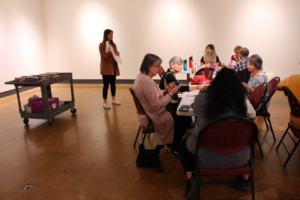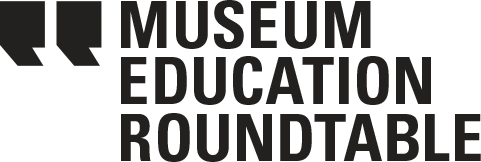From the Field: Re-imagining Docent Engagement
Interview with Jenna S. Green – Student Gallery Guide at the University of Arizona Museum of Art
This current issue of the JME “Re-imagining Docent Engagement” looks at the role of docents in museum settings — the history of programs and continuing changes in the field. The articles featured in this issue consider current issues in docent training and re-imagine a future for docent roles moving forward. I was inspired by the topic to learn more about docent programs and what it is like to be a docent at a museum. Earlier this summer, I had the opportunity to sit down and have a conversation with my colleague and friend Jenna S. Green, who became a gallery guide at the University of Arizona Museum of Art last year.
Beatriz: Can you talk about why you wanted to become a docent or gallery guide at the museum?
Jenna: I am a student gallery guide at the University of Arizona Museum of Art (UAMA). The overall program is called the “Docent and Gallery Guide” program as Willa Ahlschwede, who is the assistant curator of education and public programs gives people a choice as to what term they want to use. I’ve been a part of that for about one year. I joined the program at the start of the second year of my doctoral studies at the University of Arizona. And I decided to join because, previously, I worked in museums and had left a museum education job to come to graduate school. During the first year of my PhD, I was very dedicated to the academic side of learning, and by my second year I began to really miss the practical part of teaching. I missed being in the gallery and doing what I loved, so I wanted to get back into teaching that was beyond the graduate classroom. I heard about the Gallery Guide program at the UAMA from my advisor Carissa DiCindio, who let our graduate class know about the open call to join the program. I was familiar with most of the museum staff through other events and opportunities, but I decided to join the museum as a guide in this more formal program. It’s been great!
Beatriz: Being able to teach in a museum while you go through graduate school is so valuable! It is wonderful that the UAMA has a gallery guide program open to graduate students. Can you talk a little bit about the program, how it works and your teaching experience?
Jenna: The Gallery Guide program is run by Willa Ahlschwede, who is the assistant curator of education and public programs. She is wonderful and organizes our regular meetings, which take place on Mondays. The meetings help us as guides to socialize and get to know one another, and there is also an emphasis on learning rather than “training.” I also feel it’s important to mention that the museum does give student guides a small financial award at the end of the semester based on how many tours or programs you help with throughout the semester. It’s a way in which the museum acknowledges our work and effort in teaching, which is lovely.
To answer your question about a teaching experience, I wanted to share one specific teaching experience I had at the museum back in the fall of 2023. The museum staff knows that I love this connection between art and wellbeing, and so Willa invited me to participate and help lead a series of tours for the internal medicine residents on campus. At the University of Arizona, we actually have a growing partnership between the art museum and the med school, which means some of the students have had some exposure to medical humanities. So — to my knowledge — this was the second year of tours offered to first-year medical school students, and it was the very first time that residents were invited to join the program and tour the museum. I was super excited to be part of this program, and I had the opportunity to help lead five tours for the internal medicine residents.

I should also note that I was invited to be involved throughout the process. This began with me joining meetings with the staff and faculty from medical humanities to establish goals for each session and what they wanted the residents to get out of the experience. In addition to promoting and helping students harness observational skills, slow looking and reflection, we were also intentional about fun and playfulness. I led a couple of activities with the residents: one of which was called “Sound Symphony.” It was interesting and fun to see some of the residents start off a little uncomfortable and then work through that discomfort and relax. It was a little awkward and some people were a little closed off, but throughout the tours and gallery activities, we saw them loosen up and feel like they were welcome and belonged in the space. I was more interested in getting the residents to talk and discuss what they observed — not even through an art historical lens or anything but just purely based on what they saw and their own interpretations.
I think this is common and true with most tours we lead as gallery educators or docents, and it can be a challenge. We often go into a program, or a tour, and we don’t know how or what the group will be like on a particular day. For example, during one tour, we could have a group that goes through an activity quickly, and then we must pivot to something else. Or it could take much longer than anticipated and we might have to cut something out. These experiences and challenges were helpful for me as a graduate student to be able to go through, beyond just reading about them in a book.
Beatriz: That is wonderful! I think that experience of being able to teach in the gallery is so invaluable as an art museum ed student. Because as educators, we know that you can read about all this theory — the articles and read all the books and different methods and strategies — but there are certain things that you can only learn by doing and by making mistakes, or by figuring out in real time with a live audience and visitors.
Jenna: Yeah, I completely agree, and I think something else that I really enjoyed about working with this group at UAMA, and just my overall experience as a guide, is that it is really collaborative; it doesn’t really feel like there’s a hierarchy. For example, with the medical resident tours I helped with, there was myself, Willa, and then the medical humanities faculty, and we each took turns leading an activity. In this way, we were all working together, and it felt supportive. We were more so co-teachers.
Beatriz: I love that collaborative aspect of teaching in museums! So, I know you are a PhD student, and you are passionate about museums, research and teaching. How do your roles as a museum educator, student and docent/guide influence or inform one another?
Jenna: It’s been beneficial in multiple ways: one of which I already mentioned — that kind of embodying the practice of teaching. For me at least, practice is important; I need to be able to teach multiple times to feel good about it. I think with teaching, similarly, to learning languages, we must keep “flexing the muscle” and practicing. Being a gallery guide also makes me feel more connected to the museum institution and the museum community. I also really enjoy building stronger connections with other UAMA staff members and helping with other projects and tours. There have been several times where I’ve been asked to help with workshops or tours taking place at the museum that tie directly with my strengths and research interests.
Beatriz: Your experience as a gallery guide sounds wonderful and just super beneficial in continuing to further develop your teaching skills. I am curious if there is an article or topic in this next JME issue that you are excited about reading?
Jenna: Yes, I am looking forward to reading Porchia Moore’s article featured in 49.2 titled “From Docent to Professional to Activist to Critical Race Theorist: A Biomythography of Black American Museum Professional.” This topic immediately caught my attention, and I think its presence is needed in the issue. I am excited to read this one and learn more about this — specifically about “the sensationalism of the battles over the fate of docent groups considering the need to make fundamental shifts in museum praxis.”
Jenna S. Green is a PhD student in Art & Visual Culture Education at the University of Arizona. Her research interests are on trauma-aware art museum education and the social/care work of museums, contemplative and embodied pedagogies, and medical humanities. She draws on feminist ethics of care, post-critical museology, and arts-based research. Currently she is the Communications Specialist at the Western Museums Association but prior to this position, she was the Senior Museum Educator at the Frank Lloyd Wright Foundation – Taliesin West and the Program Manager for the Glass Art Society. She has been in the museum field since 2017, and in 2019 earned a Master of Arts in Museology, with a specialization in Evaluation, from the University of Washington.

